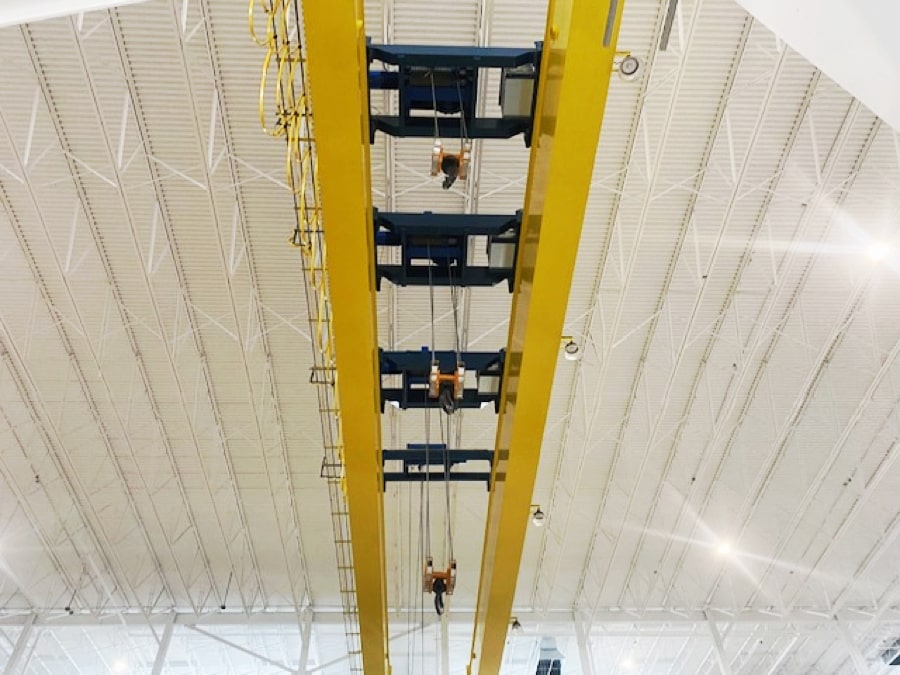Thursday, April 18th, 2024 | 416 views
This article provides a general overview that will assist decision-makers in understanding the operational details of overhead cranes, and aid them in making informed purchasing decisions. It also highlights their components, operational mechanisms, and the significant benefits they bring to modern construction and manufacturing environments.
What is an Overhead Crane
 Overhead cranes – also known as bridge cranes – are essential tools in the construction and manufacturing industry, designed to lift, lower, and move heavy loads with precision across a fixed path. They also enhance operational efficiency and safety by enabling precise handling of materials without occupying valuable floor space with lifting equipment.
Overhead cranes – also known as bridge cranes – are essential tools in the construction and manufacturing industry, designed to lift, lower, and move heavy loads with precision across a fixed path. They also enhance operational efficiency and safety by enabling precise handling of materials without occupying valuable floor space with lifting equipment.
The Basics of How Overhead Cranes Work
Core Components of Overhead Cranes
An overhead crane typically comprises three major components: the bridge, the hoist, and the runway.
The bridge spans the area over which materials need to be moved and can be single or double girder based on weight requirements and the length of the workspace required.
The hoist – the critical lifting component of the crane – is mounted on a trolley that moves across the bridge and allows for lateral movement of loads.
Lastly, the runway allows the entire crane to smoothly move back and forth along the working area, facilitating efficient handling of materials.
Here you’ll find a list of the most common parts and components of a crane.
Operational Mechanisms

The operational efficiency of an overhead crane is governed by several key mechanisms: motors, the hoist, and the lift-wheel system.
Electric motors drive the trolley and the bridge, ensuring smooth and controlled motion. The hoist operates through a series of wire ropes or chains, managed by a drum or lift-wheel system. These components work synchronously to execute precise lifting and lowering operations.
Advanced models are equipped with variable frequency drives (VFDs), which provide greater control over speed and positioning. This enhances the crane’s performance in delicate lifting operations and improves overall safety and productivity by minimizing the risk of load damage.
Safety and Efficiency
Safety is paramount in the design and operation of overhead cranes. Equipped with limit switches, emergency stop features, and overload sensors, these cranes ensure a safe working environment by preventing accidents and equipment damage.
Additionally, the ability to operate at high speeds and handle substantial loads reduces cycle times and enhances productivity in manufacturing settings.
The crane’s precise load control minimizes wear and tear on mechanical components, extends the lifespan of the equipment and reduces maintenance costs.
Applications in Construction and Manufacturing

Overhead cranes can be adapted to a wide range of tasks. They play a crucial role in moving large structural components, such as steel beams and precast concrete panels, facilitating the swift assembly of buildings and infrastructure.
In automotive manufacturing, overhead cranes are responsible for transporting heavy parts like engines and chassis throughout the production facility. In metal fabrication plants they are used to maneuver raw materials and finished products through various stages of production.
The crane’s ability to handle heavy and oversized loads makes them indispensable in heavy industries such as steel production, shipbuilding, and the manufacturing of large machinery. They provide the muscle and precision needed to significantly impact productivity and safety in high-demand environments.
Advantages Over Other Lifting Equipment
Compared to forklifts and other ground-based lifting devices, overhead cranes offer significant advantages. Their ability to lift loads vertically and transport them horizontally across a large area without occupying floor space allows for optimal utilization of manufacturing facilities.
Overhead cranes reduce the risk of product damage and personal injury, as they are operated from a safe distance and can maneuver loads above obstructions on the factory floor.
This spatial efficiency is in high demand in plants where floor space is at a premium.
Making the Decision to Purchase
Investing in an overhead crane is a decision that can significantly impact the efficiency, safety, and productivity of a manufacturing operation. Prospective buyers should first consider the specific needs of their manufacturing processes, including load capacity, span, lifting height, and speed requirements. From there you can speak to our team about the options and features you require so it meets the demands of your operations and delivers a strong return on investment.
Once you’re ready to get started, we’ll show you how it can be integrated into your existing operations and enhance throughput and safety.
Keep in mind that with their robust design, versatility, and advanced safety features, overhead cranes represent a sound investment in the long-term success of your operational goals.
